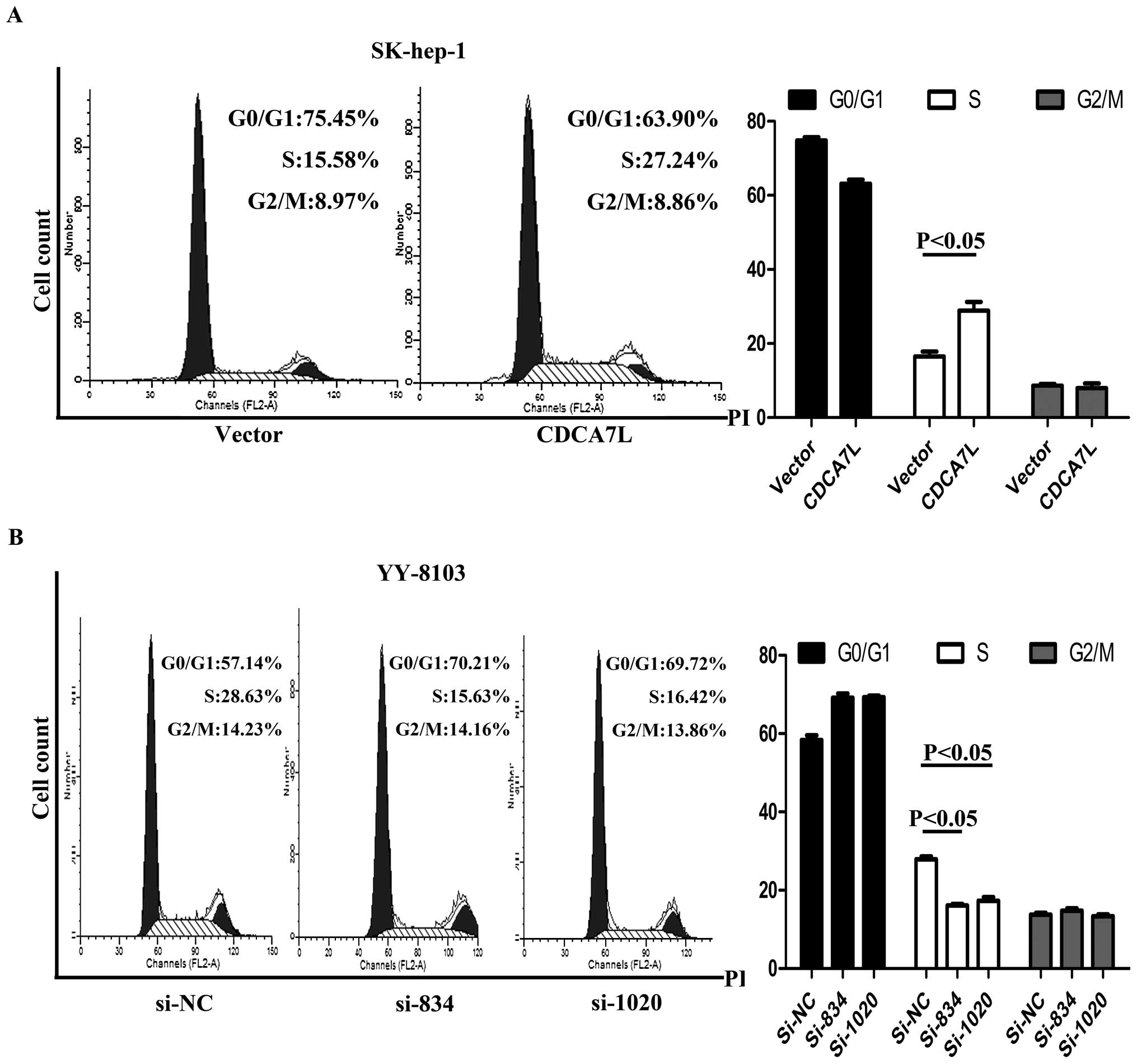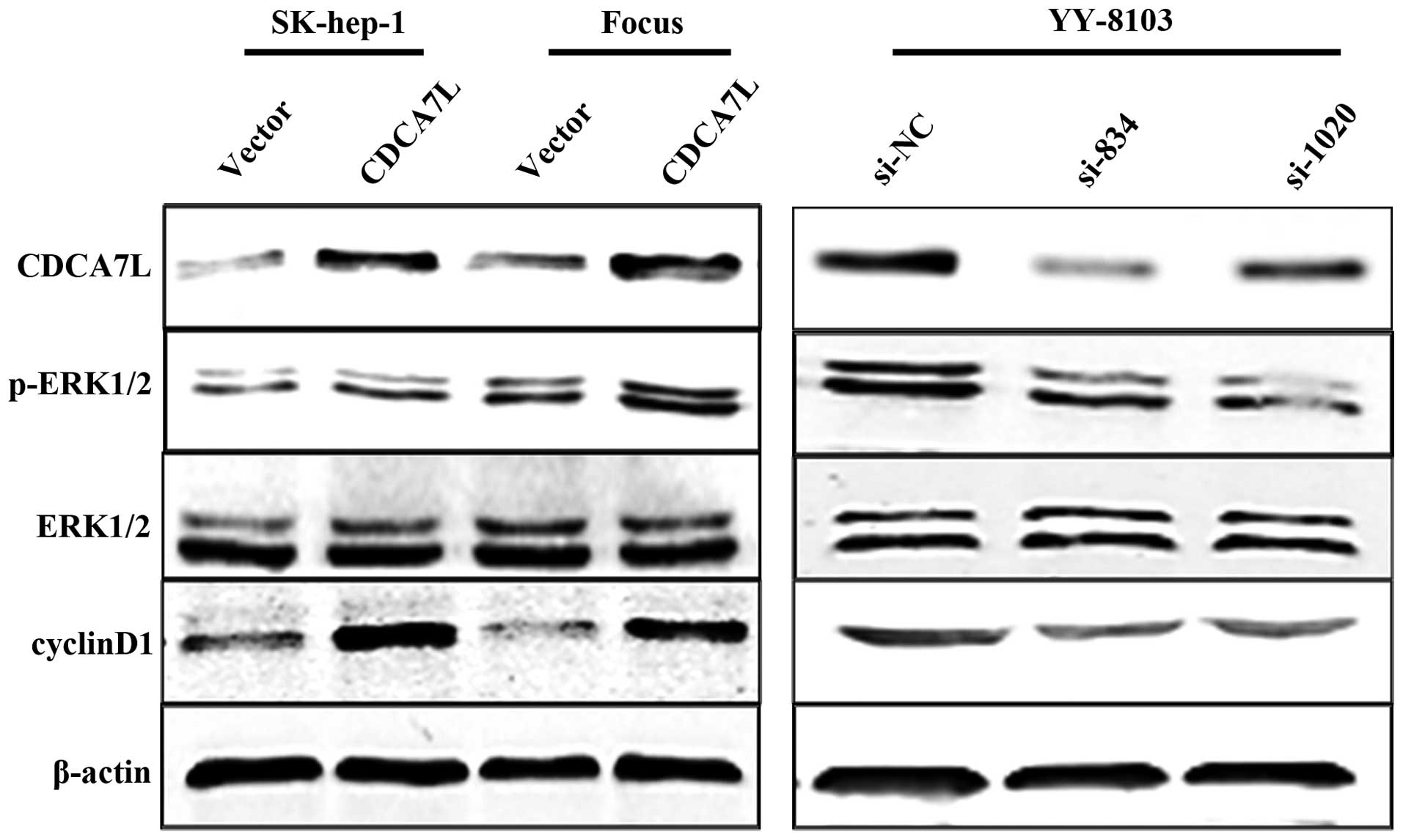|
1.
|
Kan Z, Zheng H, Liu X, et al: Whole genome
sequencing identifies recurrent mutations in hepatocellular
carcinoma. Genome Res. 23:1422–1433. 2013. View Article : Google Scholar : PubMed/NCBI
|
|
2.
|
Wei Y, Doria C and Liu Y: Targeted
therapies in the treatment of advanced hepatocellular carcinoma.
Clin Med Insights Oncol. 7:87–102. 2013. View Article : Google Scholar : PubMed/NCBI
|
|
3.
|
Dai L, Lei N, Liu M and Zhang JY:
Autoantibodies to tumor-associated antigens as biomarkers in human
hepatocellular carcinoma (HCC). Exp Hematol Oncol. 2:15–21. 2013.
View Article : Google Scholar : PubMed/NCBI
|
|
4.
|
Shiraha H, Yamamoto K and Namba M: Human
hepatocyte carcinogenesis (Review). Int J Oncol. 42:1133–1138.
2013.PubMed/NCBI
|
|
5.
|
Wang X, Chen J, Li F, et al: MiR-214
inhibits cell growth in hepatocellular carcinoma through
suppression of β-catenin. Biochem Biophys Res Commun. 428:525–531.
2012.PubMed/NCBI
|
|
6.
|
Hakami A, Ali A and Hakami A: Effects of
hepatitis B virus mutations on its replication and liver disease
severity. Open Virol J. 7:12–18. 2013. View Article : Google Scholar : PubMed/NCBI
|
|
7.
|
Jeong SW, Jang JY and Chung RT: Hepatitis
C virus and hepatocarcinogenesis. Clin Mol Hepatol. 18:347–356.
2012. View Article : Google Scholar : PubMed/NCBI
|
|
8.
|
Zhao Y, Jian W, Gao W, et al: RNAi
silencing of c-Myc inhibits cell migration, invasion, and
proliferation in HepG2 human hepatocellular carcinoma cell line:
c-Myc silencing in hepatocellular carcinoma cell. Cancer Cell Int.
13:23–28. 2013. View Article : Google Scholar : PubMed/NCBI
|
|
9.
|
Oster SK, Ho CS, Soucie EL and Penn LZ:
The myc oncogene: MarvelouslY Complex. Adv Cancer Res. 84:81–154.
2002. View Article : Google Scholar : PubMed/NCBI
|
|
10.
|
Pelengaris S and Khan M: The many faces of
c-MYC. Arch Biochem Biophys. 416:129–136. 2003. View Article : Google Scholar : PubMed/NCBI
|
|
11.
|
Facchini LM and Penn LZ: The molecular
role of Myc in growth and transformation: recent discoveries lead
to new insights. FASEB J. 12:633–651. 1998.PubMed/NCBI
|
|
12.
|
Schmidt EV: The role of c-myc in cellular
growth control. Oncogene. 18:2988–2996. 1999. View Article : Google Scholar : PubMed/NCBI
|
|
13.
|
Boyd KE and Farnham PJ: Myc versus USF:
discrimination at the cad gene is determined by core promoter
elements. Mol Cell Biol. 17:2529–2537. 1997.PubMed/NCBI
|
|
14.
|
Bello-Fernandez C, Packham G and Cleveland
JL: The ornithine decarboxylase gene is a transcriptional target of
c-Myc. Proc Natl Acad Sci USA. 90:7804–7808. 1993. View Article : Google Scholar : PubMed/NCBI
|
|
15.
|
Wu S, Pena A, Korcz A, Soprano DR and
Soprano KJ: Over expression of Mxi1 inhibits the induction of the
human ornithine decarboxylase gene by the Myc/Max protein complex.
Oncogene. 12:621–629. 1996.PubMed/NCBI
|
|
16.
|
Shim H, Dolde C, Lewis BC, Wu CS, Dang G,
Jungmann RA, Dalla-Favera R and Dang CV: c-Myc transactivation of
LDH-A: implications for tumor metabolism and growth. Proc Natl Acad
Sci USA. 94:6658–6663. 1997. View Article : Google Scholar : PubMed/NCBI
|
|
17.
|
Hubank M and Schatz DG: Identifying
differences in mRNA expression by representational difference
analysis of cDNA. Nucleic Acids Res. 22:5640–5648. 1994. View Article : Google Scholar : PubMed/NCBI
|
|
18.
|
Perez-Roger I, Solomon DL, Sewing A and
Land H: Myc activation of cyclin E/Cdk2 kinase involves induction
of cyclin E gene transcription and inhibition of p27(Kip1) binding
to newly formed complexes. Oncogene. 14:2373–2381. 1997. View Article : Google Scholar : PubMed/NCBI
|
|
19.
|
Galaktionov K, Chen X and Beach D: Cdc25
cell-cycle phosphatase as a target of c-myc. Nature. 382:511–517.
1996. View
Article : Google Scholar : PubMed/NCBI
|
|
20.
|
Ou XM, Chen K and Shih JC: Monoamine
oxidase A and repressor R1 are involved in apoptotic signaling
pathway. Proc Natl Acad Sci USA. 103:10923–10928. 2006. View Article : Google Scholar : PubMed/NCBI
|
|
21.
|
Huang A, Ho CS, Ponzielli R, et al:
Identification of a novel c-Myc protein interactor, JPO2, with
transforming activity in medulloblastoma cells. Cancer Res.
65:5607–5619. 2005. View Article : Google Scholar : PubMed/NCBI
|
|
22.
|
Chen K, Ou XM, Chen G, et al: R1, a novel
repressor of the human monoamine oxidase A. J Biol Chem.
280:11552–11559. 2005. View Article : Google Scholar : PubMed/NCBI
|
|
23.
|
Johnson S, Stockmeier CA, Meyer JH, et al:
The reduction of R1, a novel repressor protein for monoamine
oxidase A, in major depressive disorder. Neuropsychopharmacology.
36:2139–2148. 2011. View Article : Google Scholar : PubMed/NCBI
|
|
24.
|
Dai CX, Gao Q, Qiu SJ, et al:
Hypoxia-inducible factor-1 alpha, in association with inflammation,
angiogenesis and MYC, is a critical prognostic factor in patients
with HCC after surgery. BMC Cancer. 9:418–428. 2009. View Article : Google Scholar : PubMed/NCBI
|
|
25.
|
Dituri F, Mazzocca A, Peidro FJ, et al:
Differential inhibition of the TGF-b signaling pathway in HCC cells
using the small molecule inhibitor LY2157299 and the D10 monoclonal
antibody against TGF-b receptor type II. PLoS One. 8:67109–67123.
2013. View Article : Google Scholar : PubMed/NCBI
|
|
26.
|
Lin C-P, Liu C-R, Lee C-N, et al:
Targeting c-Myc as a novel approach for hepatocellular carcinoma.
World J Hepatol. 2:16–20. 2010.PubMed/NCBI
|
|
27.
|
Prescott JE, Osthus RC, Lee LA, et al: A
novel c-Myc-responsive gene, JPO1, participates in neoplastic
transformation. J Biol Chem. 276:48276–48284. 2001.PubMed/NCBI
|
|
28.
|
Goto Y, Hayashi R, Muramatsu T, et al:
JPO1/CDCA7, a novel transcription factor E2F1-induced protein,
possesses intrinsic transcriptional regulator activity. Biochim
Biophys Acta. 1759:60–68. 2006. View Article : Google Scholar
|
|
29.
|
Osthus RC, Karim B, Prescott JE, et al:
The Myc target gene JPO1/CDCA7 is frequently overexpressed in human
tumors and has limited transforming activity in vivo. Cancer Res.
65:5620–5627. 2005. View Article : Google Scholar : PubMed/NCBI
|
|
30.
|
Gill RM, Gabor TV, Couzens AL, et al: The
MYC-associated protein CDCA7 is phosphorylated by AKT to regulate
MYC-dependent apoptosis and transformation. Mol Cell Biol.
33:498–513. 2012. View Article : Google Scholar : PubMed/NCBI
|
|
31.
|
Wang H, Wu K, Sun Y, et al: STC2 is
upregulated in hepatocellular carcinoma and promotes cell
proliferation and migration in vitro. BMB Rep. 45:629–634. 2012.
View Article : Google Scholar : PubMed/NCBI
|
|
32.
|
Sherr CJ: Cancer cell cycles. Science.
274:1672–1677. 1996. View Article : Google Scholar : PubMed/NCBI
|
|
33.
|
Braun-Dullaeus RC, Mann MJ, Sedding DG,
Sherwood SW, von der Leyen HE and Dzau VJ: Cell cycle-dependent
regulation of smooth muscle cell activation. Arterioscler Thromb
Vasc Biol. 24:845–850. 2004. View Article : Google Scholar : PubMed/NCBI
|
|
34.
|
Braun-Dullaeus RC, Man MJ and Dzau VJ:
Cell cycle progression: new therapeutic target for vascular
proliferative disease. Circulation. 98:82–89. 1998. View Article : Google Scholar : PubMed/NCBI
|
|
35.
|
Tarn WY and Lai MC: Translational control
of cyclins. Cell Div. 6:5–13. 2011. View Article : Google Scholar
|
|
36.
|
Ajchenbaum F, Ando K, DeCaprio JA and
Griffin JD: Independent regulation of human D-type cyclin gene
expression during G1 phase in primary human T lymphocytes. J Biol
Chem. 268:4113–4119. 1993.PubMed/NCBI
|
|
37.
|
Liu Y, Li W, Ye C, et al: Gambogic Acid
induces G0/G1 cell cycle arrest and cell migration inhibition via
suppressing PDGF receptor β tyrosine phosphorylation and Rac1
activity in Rat aortic smooth muscle cells. J Atheroscler Thromb.
17:901–913. 2010.PubMed/NCBI
|















